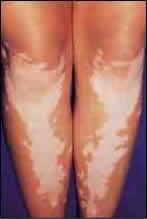PrincessLNJ
Proud Member
- Joined
- Jul 25, 2011
- Messages
- 142
- Points
- 0
Not simply a black and white case

THE amazing case this week of a young woman whose black skin went completely white because of the condition vitiligo was enough to make anyone stop and stare.
But the transformation that pretty fashion designer Darcel de Vlugt, 23, went through is more common than most of us might think - adding weight to claims that Michael Jackson's change in skin colour was indeed medical rather than cosmetic.
Professor David Gawkrodger, consultant dermatologist at Sheffield Teaching Hospitals NHS Trust, said: "It's widely accepted now that Michael Jackson suffered from vitiligo and I do suspect he used depigmenting creams to clear the remaining pigment from his skin.
"The condition often results in smaller patches of skin losing pigment, but the whole body can lose its colouring."
While it is never life-threatening, vitiligo has a crippling affect on self-esteem. Prof Gawkrodger said: "Because it affects visible parts of the body like the hands and face, it's hugely distressing, especially for black and Asian people as the white patches really stand out."
Glamorous Darcel, from London, was born to black parents from Trinidad. She was teased remorselessly during her teenage years.
With her skin peeling off in patches she was cruelly dubbed "spotty" and "dalmatian".
Retired librarian Maxine Whitton, 58, understands the mental torture that accompanies the condition. She first developed vitiligo aged 11. Maxine, from east London, said: "In my early teens it appeared on my face, with great big patches around my eyes and my lips.
"For a teenager to go through that was terrible - I had lots of friends, but no boyfriends and I felt like I'd never have one.
"It is hard to describe how upset I was at the public reaction to Michael Jackson, but hopefully his case will make people more sympathetic to what it can do to you.
"Thankfully none of my children or grandchildren have it yet, but I pray every day they won't get diagnosed with this awful disease."
Vitiligo affects up to two per cent of the population. Pigment cells in the skin are destroyed, leaving a mottled, spotty white appearance that often spreads.
A third of people with vitiligo have a family history of it and it is equally common in all races but more visible in darker skin.
Advertisement
Prof Gawkrodger said: "We have some idea of what's happening, but are less clear on why.
"While there are several theories, the most widely accepted is that your own immune system attacks your skin pigment cells. Why it does this is anybody's guess.
"There's no cure and most treatments to halt or reverse it are largely disappointing."
There are options, though, including creams to repigment white patches, specialist make-up or six-month courses of ultra-violet light treatment.
But Prof Gawkrodger explained: "Best results are achieved by treating it as soon as possible and seeing what works. We desperately need more research into its treatment, but the funding simply isn't there."
http://www.thesun.co.uk/sol/homepag...hite-skin-change-raises-Jackson-question.html
The black girl who turned into a white woman after vitiligo changed colour of her entire body | Mail Online


THE amazing case this week of a young woman whose black skin went completely white because of the condition vitiligo was enough to make anyone stop and stare.
But the transformation that pretty fashion designer Darcel de Vlugt, 23, went through is more common than most of us might think - adding weight to claims that Michael Jackson's change in skin colour was indeed medical rather than cosmetic.
Professor David Gawkrodger, consultant dermatologist at Sheffield Teaching Hospitals NHS Trust, said: "It's widely accepted now that Michael Jackson suffered from vitiligo and I do suspect he used depigmenting creams to clear the remaining pigment from his skin.
"The condition often results in smaller patches of skin losing pigment, but the whole body can lose its colouring."
While it is never life-threatening, vitiligo has a crippling affect on self-esteem. Prof Gawkrodger said: "Because it affects visible parts of the body like the hands and face, it's hugely distressing, especially for black and Asian people as the white patches really stand out."
Glamorous Darcel, from London, was born to black parents from Trinidad. She was teased remorselessly during her teenage years.
With her skin peeling off in patches she was cruelly dubbed "spotty" and "dalmatian".
Retired librarian Maxine Whitton, 58, understands the mental torture that accompanies the condition. She first developed vitiligo aged 11. Maxine, from east London, said: "In my early teens it appeared on my face, with great big patches around my eyes and my lips.
"For a teenager to go through that was terrible - I had lots of friends, but no boyfriends and I felt like I'd never have one.
"It is hard to describe how upset I was at the public reaction to Michael Jackson, but hopefully his case will make people more sympathetic to what it can do to you.
"Thankfully none of my children or grandchildren have it yet, but I pray every day they won't get diagnosed with this awful disease."
Vitiligo affects up to two per cent of the population. Pigment cells in the skin are destroyed, leaving a mottled, spotty white appearance that often spreads.
A third of people with vitiligo have a family history of it and it is equally common in all races but more visible in darker skin.
Advertisement
Prof Gawkrodger said: "We have some idea of what's happening, but are less clear on why.
"While there are several theories, the most widely accepted is that your own immune system attacks your skin pigment cells. Why it does this is anybody's guess.
"There's no cure and most treatments to halt or reverse it are largely disappointing."
There are options, though, including creams to repigment white patches, specialist make-up or six-month courses of ultra-violet light treatment.
But Prof Gawkrodger explained: "Best results are achieved by treating it as soon as possible and seeing what works. We desperately need more research into its treatment, but the funding simply isn't there."
http://www.thesun.co.uk/sol/homepag...hite-skin-change-raises-Jackson-question.html
The black girl who turned into a white woman after vitiligo changed colour of her entire body | Mail Online





